Using STA Certified Compost – Manufacturer Requirements: Compost Characteristics
Compost – Characteristics and Why it Matters
Each batch of compost can be differentiated based on key measurable attributes. The levels of each of these characteristics impacts whether the batch is high quality compost. The relative levels determine the best use for that batch (i.e. turf growth, vegetables, etc).
When using a batch of compost it is very important to know its characteristics (usually found on its Compost Technical Data Sheet) and to be able to identify if they correspond to the intended use.
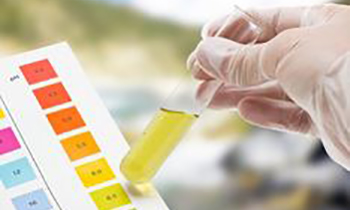
pH
pH is the measure of acidity (or alkalinity), or hydrogen ion activity of a soil or compost (on a logarithmic scale). The pH scale ranges from 0 to 14, with a pH of 7 indicating neutrality.
A pH change of 1 unit means a 10X increase or decrease of acidity. Most composts have a pH of between 6 and 8. Each specific plant species requires a specific pH range. Based on the amount of compost applied, as well as its pH, compost can affect the pH of the soil or growing media.
To gauge the effect, pH is a necessary parameter you need to know. Soil pH is often adjusted by using materials such as lime (to raise pH) and sulfur (to lower pH). When liming agents are used in the production of the compost product you use, or are in the source materials of the compost, the compost may be more or less appropriate for your specific application (please confer with your compost supplier).
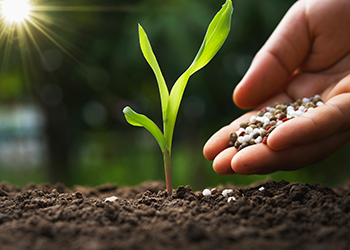
Soluble Salts (Including from nutrients)
Soluble salts refers to the amount of soluble ions in a solution of compost and water. The concentration of soluble ions is typically estimated by determining the solution’s ability to carry an electrical current, i.e., electrical conductivity.
The units of measure for soluble salts are either mmhos/cm or dS/m (they are 1:1 equivalent). Plant essential nutrients are actually supplied to plants in a salt form. While some specific soluble salts, (e.g., sodium, chloride), may be more detrimental to plants, most composts do not contain sufficient levels of these salts to be a concern in landscape applications.
Plant species have a salinity tolerance rating and maximum tolerable quantities are known. Excess soluble salts can cause phytotoxicity to plants. Compost may contribute to, or dilute, the cumulative soluble salts content of a growing media or soil. Reduction in soluble salts content can be achieved through thorough watering at the time of planting. Most composts have a soluble salt conductivity of 1.0 to 10.0 dS/m, whereas typical conductivity values in soil range from 0 to 1.5 in most areas of the country.
As the N.C. Department of Agriculture and Consumer Services' Agronomic Division says in their book, "Since most plant nutrients in fertilizers are formulated as salts, the soluble salts number is an indication of the fertility level of the substrate. When fertility is too high, salts can cause injury to plant roots. Composition of the substrate, moisture level, texture, temperature and other factors determine the potential for soluble salt problems. As a general rule, plants growing in substrates with high cation exchange (CEC) and water-holding capacities can tolerate higher fertility and soluble salt levels."

Specific Nutrients
In general, nutrients found in compost are in an ‘organic’ form, meaning that they are released slowly from microbes as they further decompose the compost. Nitrogen (N), phosphorus (P, usually expressed as P2O5), and potassium (K, usually expressed as K20) are the three nutrients utilized by plants in the greatest quantities, and are the nutrients most often contained in commercial and retail fertilizers.
When purchased in bags of fertilizer, these three nutrients are measured and expressed on a dry weight basis, in the form of a percentage (%). In compost, nutrient content may be expressed on a dry, or wet weight (as received) basis. Knowing the content of these nutrients will help you make correct decisions about the addition of supplemental fertilization.
Although concentrations of nutrients found in compost are typically not high, in comparison to most fertilizer products, compost is usually applied at much greater rates, and therefore, can represent a significant cumulative quantity. The nutrient content of compost products varies widely; however, biosolids and animal manure based composts typically contain more total nutrition. The use of certain composts may reduce or eliminate the necessity to fertilize certain plants during the first 6 –12 months following its application.
Aside from N, P and K, calcium (Ca) and magnesium (Mg) are also monitored in STA Certified Compost Program testing. The content of these nutrients is reported in the STA Certified Compost Technical Data Sheet on both a dry weight basis (just like fertilizers), and on ‘as received’ or ‘wet weight’ basis (because composts contain a much higher amount of moisture, than do fertilizers).

Moisture
Moisture percent (content) is the measure of the quantity of water present in a compost product; expressed as a percentage of total weight. The moisture content of compost affects its bulk density (weight per unit volume) and, therefore, affects handling and transportation. Overly dry compost (35% moisture, or below) can be dusty and irritating to work with, while very wet compost (55 to 60%) can become heavy and clumpy, making its application more difficult and delivery more expensive. A preferred moisture percent for finished compost is 40 -50%.

Organic Matter
Organic matter content is the measure of carbon-based materials in compost. Organic matter content is typically expressed as a percentage of dry weight. Organic matter is an important ingredient in all soils and plays an important role in soil structure, nutrient availability, and water holding capacity.
Being aware of a product’s organic matter content is useful for estimating the age and physical properties of the compost. It may also be necessary for determining compost application rates on certain applications, such as turf establishment and agricultural crop production. In these applications, standard agricultural soil test kits are often used to determine recommended application rates of organic matter. However, these application rates are specified as the quantity of organic matter needed on a per acre basis. Therefore, the organic matter content of the compost must be known in order to convert the suggested application rate into a usable form (tons/acre). There is no ideal organic matter content for compost, and it may vary widely, ranging from 30 to 70%.
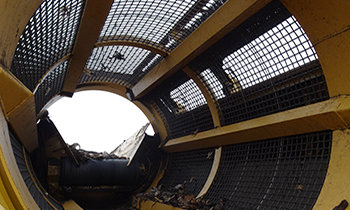
Particle Size
The way in which compost particle size is measured, and expressed, is typically based on the product’s end use. For most applications, merely specifying the product’s maximum particle size, or the screen size through which it passes, is sufficient.
However, for certain applications, such as golf ‘greens’ mix or potting media production, a complete particle size distribution may be required. Particle size distribution measures the amount of compost meeting a specific particle size range, by using a series of sieves (screens) to capture compost particles of specific size. A compost product’s particle size may also determine its usability in specific applications. For example, a compost product with a maximum particle size of 1/2 inch or greater may not be acceptable as a turf top-dressing, whereas a product with a maximum particle size of 1/4 to 3/8 inch or less could be acceptable. Most composts that are used as soil amendments are screened through a 3/8 or 1/2 inch screen.
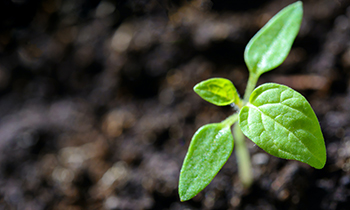
Maturity
Maturity is the degree or level of completeness of composting. Maturity is not described by a single property and therefore, maturity is best assessed by measuring two or more compost characteristics. Some immature composts may contain high amounts of free ammonia, certain organic acids or other water-soluble compounds which can limit seed germination and root development, or cause odor. All uses of compost require a mature product free of these potentially phytotoxic components. The bioassay used in the STA Certified Compost Program uses a seed germination and growth test to measure the percent of seed emergence and relative seedling vigor. Immature compost top-dressed on soil is not recommended for immediately directly sowing of seeds.
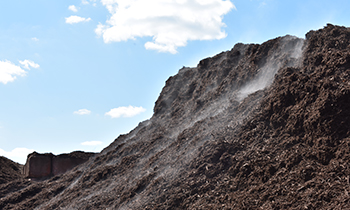
Stability
Stability refers to a specific stage or state of organic matter decomposition during composting, which is related to the type of organic compounds remaining and the resulting biological activity in the material. The stability of a given compost is important in determining the potential impact of the material on nitrogen availability in soil or growth media, and maintaining consistent volume and porosity in container growth media. Most uses of compost require a stable to very stable product that will prevent nutrient tie up and maintain or enhance oxygen availability in soil or growth media. Gravimetric (grams total solids (CO2-C/g TS/day)) may be converted to volumetric (liters of as-received compost (mg CO2-C/Liter/day)) by this formula: Liters = (g TS)*(1/(%solids/100)*(1/as received bulk density)

Inerts
Man-made inerts consist of materials created by humans and may be a part of the waste stream. These include: textiles, glass, plastic, and metal objects. When put into the composting process, these materials are not decomposed but may be degraded to some extent in physical characteristics, primarily through size reduction. These materials can decrease the value of the finished compost product because they offer no benefit to the compost and, in many cases, are aesthetically offensive. A common means of controlling man-made inerts is to minimize their entry into the waste stream being composted. Control is also accomplished through separation at the source during feedstock recovery at the composting facility, or during product refinement, (e.g., screening, ballistic separation). Other ‘non’ man-made inerts, such as stones, rocks, twigs, may also be found in compost and are considered to be aesthetically offensive.

Trace Metals
Trace metals are elements whose concentrations are regulated due to the potential for toxicity to humans, animals, or plants. Regulations governing the heavy metal content of composts derived from certain feedstocks have been promulgated on both the State and Federal levels. Similar limits have even been developed for fertilizers and certain other horticultural and agricultural products. Specific trace elements, often referred to as heavy metals include arsenic, cadmium, chromium, copper, lead, mercury, molybdenum nickel, selenium, and zinc. The quantity of these elements are measured on a dry weight basis and expressed as mg/kg (milligram per kilogram) or ppm (parts per million).
Many of these elements are actually needed by plants for normal growth, although in limited quantities. Measuring the concentration of these elements, as well as other plant nutrients, can provide valuable management data relevant to the fertilizer requirements of plants and subsequent fertilizer application rates. Certain heavy metals and trace elements are also known to cause phytotoxic effects in plants (when available in very high quantities), and specific plant species are known to be more sensitive than others. These elements include boron, manganese, molybdenum, nickel, and selenium. However, these elements are not typically found in compost in detrimental quantities. All composts that contain regulated feedstocks must meet national and/or state safety standards in order to be marketed.

Pathogens
Pathogens are disease-causing organisms including, bacteria, viruses, fungi, helminths, and protozoa which may be present in raw wastes or by-products. Both plant and human pathogens are found in living organisms and are present at some background levels in the environment. The composting process must eliminate or reduce pathogens to a level that is below the threshold where the danger of transmitting diseases will occur.
Weed seeds and pathogens are inactivated or destroyed by elevated temperatures over a period of time within the composting process. The time-temperature relationship used as the Process to Further Reduce Pathogens (PFRP) effectively destroys weed seeds and pathogens in compost. The time-temperature requirement ensures plant and human pathogen destruction in compost, and is considered an effective means to determine that compost is relatively weed free.
